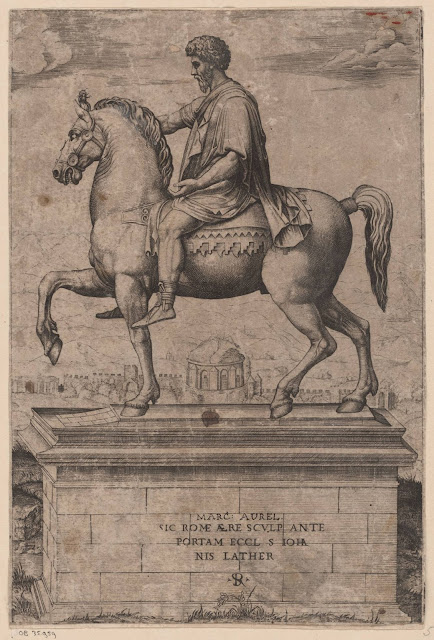 |
| Anonymous sculptor Equestrian statue of Marcus Aurelius ca. 1875 copy - bronze statuette Royal Collection, Great Britain |
 |
| Anonymous photographer Equestrian statue of Marcus Aureliius ca. 1850-70 photograph Rijksmuseum |
 |
| Underwood and Underwood, Publishers Equestrian statue of Marcus Aurelius ca. 1900 sterograph Getty Museum, Los Angeles |
The large bronze equestrian monument to Marcus Aurelius on the Capitoline Hill was reproduced as much or more than any other sculpture in Rome, but not everyone was always sure about who it was. Other names commonly in use included Antoninus Pius ; Commodus ; Constantine ; Hadrian ; Septimus Severus ; Theodoric ; Lucius Verus ; and il gran Villano. "No man had played a greater part in stimulating controversy about the quality of the statue than the sculptor Étienne-Maurice Falconet [friend of Diderot]. Resenting criticism of the bronze equestrian monument of Peter the Great which he was creating in St Petersburg, he began to launch his provocative attack on what he considered to be blind, thoughtless admiration for antique art – and especially for the Marcus Aurelius – in about 1769. He himself had in fact never seen it and his impressions of its appearance were derived partly from the Russian painter Anton Losenko who returned from Rome in that year with a series of very careful drawings after the leading antiquities and partly from a plaster cast which was specially made for him from the one in the French Academy in Rome. Using this evidence (and deriding the claim that the materials out of which the statue was made had any great significance) he criticized the horse for being badly observed, unnatural, ill-proportioned and heavy – and in so doing, he aroused much scorn, but (as we have seen) he also inspired revision of conventional responses."
 |
| after Maarten van Heemskerck Equestrian statue of Marcus Aurelius 16th century drawing British Museum |
 |
| Lawrence Alma-Tadema Equestrian statue of Marcus Aurelius 1878 drawing Rijksmuseum |
 |
| Marco Dente Equestrian statue of Marcus Aurelius ca. 1498-1527 engraving Rijksmuseum |
 |
| Richard Collin Equestrian statue of Marcus Aurelius 1677 engraving Rijksmuseum |
 |
| Etienne Dupérac after Michelangelo Plan for the Campidoglio with Equestrian statue of Marcus Aurelius at center 1568 engraving Rijksmuseum |
 |
| Gian Paolo Panini Capriccio of Roman landmarks Equestrian Marcus Aurelius at center 1735 oil on canvas Prado |
 |
| Sebastian Muller after Gian Paolo Panini Capriccio of Roman landmarks Equestrian Marcus Aurelius at center 18th century etching Rijksmuseum |
Among all the ancient statues unearthed and restored in Rome, the once-famous Apollino (below) presents the greatest challenge to the modern imagination. Like the Venus de' Medici, it occupied one of the featured pedestals in the Tribuna at the Uffizi in Florence – spaces reserved for the absolutely most superlative marbles in that superlative collection. The taste-makers and worthies of the Grand Tour left ample evidence that they adored this statue –
"... the Sweep, and the whole Contour of the Body"
It seems to have epitomized the seamless, tubular anatomy favored by people of taste in the 18th century.
 |
| Giorgio Sommor The Apollino ca. 1890 trourist postcard |
 |
| Francesco Piranesi The Apollino 1783 engraving British Museum |
It was also known as the Little Apollo or the Medici Apollo. "The Apollino was described by Northall as 'a figure well worthy to accompany the Venus de' Medici' even before it stood beside her in the Tribuna. Later it was even suggested that they were the work of the same artist. Marble copies of the two statues were often paired, as, in miniature, on the chimney-piece of the painted room of Spencer House, London, and, full-size, in the gallery of Thomas Hope's house, the Deepdene, in Surrey. Other partners were, however, possible, and in the royal palace in Stockholm a marble copy gazed across the Hall of Pillars at the Callipygian Venus. It was also linked, in literature, at least, with the Apollo Belvedere. The Vatican statue represented the god as an adult or the sun in full splendor: the Medici statue 'adolescence', or the sun at dawn. The size of the figure was not always admired, and it had to be enlarged in order for Harwood's wretched copy of it to be 'en suite' with the other statues commissioned for Syon House in Middlesex by James Adam. The latter considered the Apollino to be 'in the most agreeable attitude that could be confined in the niche'. Although Lagrenée was keen that Lamarie, who was copying the damaged cast in the French Academy in Rome in 1781, should 'correct' the original from nature, he made no criticism of the antique, and the statue's gradual fall from popular favor during the nineteenth century was not prepared for in the eighteenth."
 |
| Richard Dalton The Apollino 1746 etching, engraving British Museum |
 |
| Anonymous cast-maker The Apollino 18th-19th century full-size copy in plaster |
 |
| Anonymous sculptor The Apollino before 1846 copy - alabaster statuette birthday gift to Queen Victoria from her mother |